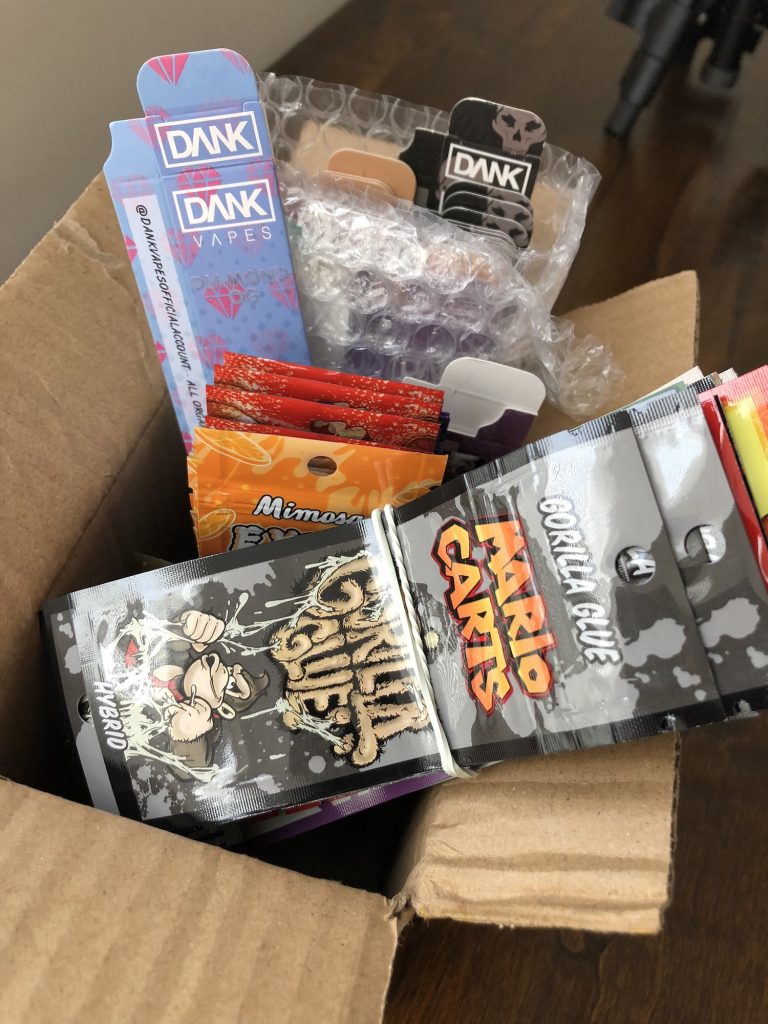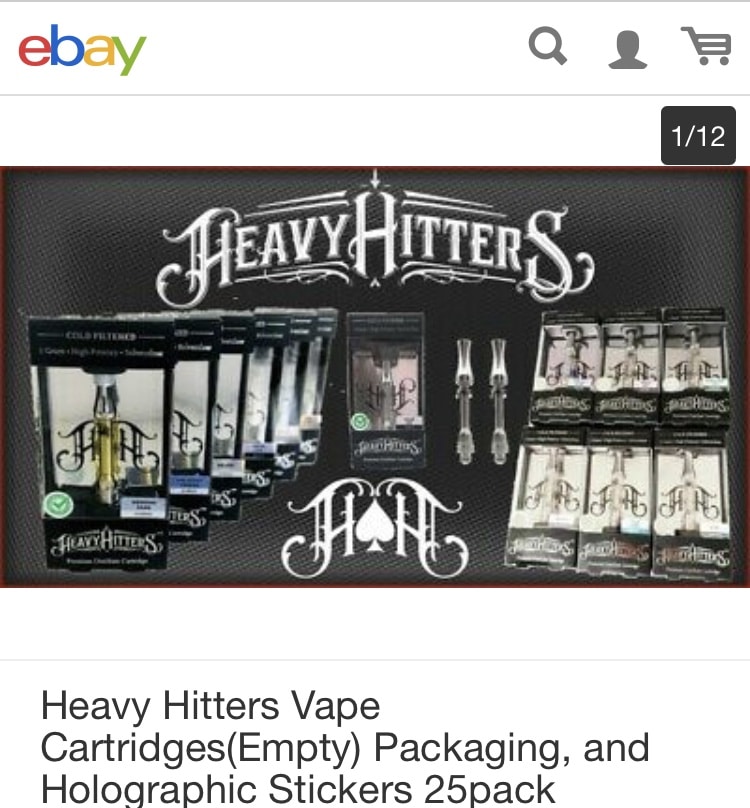Many of the vape cartridges available in Washington, DC are from brands that have been heavily compromised by counterfeits or are presented in packaging that looks like it came from a legitimate California dispensary, but the brands don’t actually exist. The Gentleman has scoured the interwebs to reveal which brands you might want to think twice about in light of the phenomenon the CDC dubbed EVALI (e-cigarette or vaping use-associated lung injury) in October 2019. Between August 2019 and February 2020, 68 deaths were linked to EVALI and thousands more hospitalizations were attributed to the use of vapes. We’re gonna go through some of the data and science but you can go straight to my Bad Vape List or my Good Vape List if you want.
2021 THC Cartridge Epidemic In DC (Summary)
- Between August 2019 and February 2020, the CDC recorded 2,807 hospitalizations and 68 deaths across the US and its territories attributable to EVALI. Although serious cases of vape-related lung diseases have fallen sharply, it’s safe to say the CDC has been, uh…busy since then. All hail the Second Horseman, eh, chaps?
- Blame has been cast on the use of Vitamin E acetate (VEA) in vape solutions, with some media reports tracking it down to the cutting agent called Honey Cut and its copycats. Many vape producers have since changed their recipes, but recent studies show that substitute ingredients like squalene and phytol probably aren’t safe either.
- There are also state reports from 2019 of metal-coiled vape cartridges leaking lead into the vape oil when heated. Almost all vapes these days use ceramic heating elements, but the latest research shows that toxic metals like lead are still getting into cannabis vape oil, even for licensed retailers with the “safest” lab-tested products.
- Some legit companies, like STIIIZY, have implemented a combination of tamper-proof packaging and serial/QR code verification through their official website to alleviate counterfeit concerns. I wouldn’t say it’s a fool-proof solution, but nothing is short of purchasing your products from a state-licensed dispensary where the state requires seed-to-sale tracking for traceability.
- The fake products I’ve mentioned below, like Mario Carts and Dank Vapes, are all still around, cuz despite the vape epidemic, demand for vape cartridges has held steady — in DC and nationally. I’d like to think that they changed their formulas when people got sick last year, but haven’t got anyone to explain on or off-record that has occurred. I stand by my advice to not use any products labeled FAKE on my Bad Vape List below.
Why Is Vaping Vitamin E Oil Dangerous?
While there’s still a lot we don’t know, there’s strong evidence that the EVALI outbreak was caused by a toxic gas that’s produced when a vape oil additive called vitamin E acetate (VEA) is heated to above 1100 degrees fahrenheit (if that seems way too hot, it is, and we’ll touch on that later). The gas is called ketene and the way it reacts in our bodies after being inhaled is considered identical to phosgene, which is a common (but extremely hazardous) industrial chemical used to make things like plastics and pharmaceutical drugs. Phosgene is also known for its use as a chemical weapon in World War One. According to Wikipedia, the biggest difference between the two is that the ketene (from heating vape oil) is eight times more toxic than the phosgene that outright killed 85,000 people during WWI (many more likely died from complications).
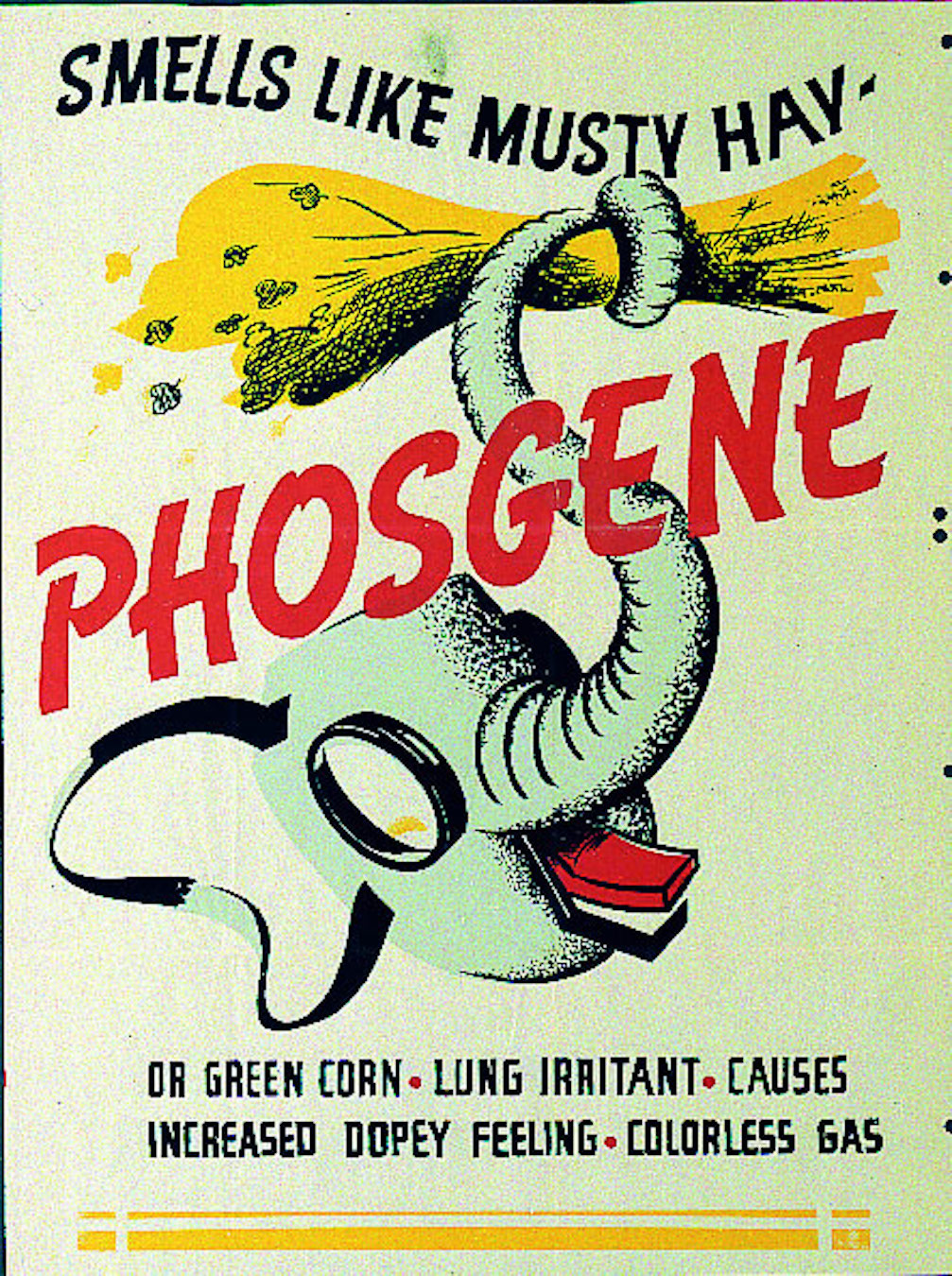
In other words, people who were affected during the vape epidemic may have been suffering from chemical burns inside their lungs. As research into the EVALI outbreak continues, we expect to see some of the original theories laid to rest, but, given the preoccupation of the respiratory researchers since, that may take some time.
This doesn’t mean that research showing other types of damage from vaping should be ignored, it just means that the most likely cause of death in most cases was acute chemical exposure. It remains to be seen whether lung inflammation caused by vape additive oil droplets (one of the original theories) made the ketene exposure worse, and it’s very likely that some deaths were unrelated to ketene gas exposure because some patients were using vapes that didn’t contain VEA (they had medium chain triglycerides or polyethylene glycol, for example).
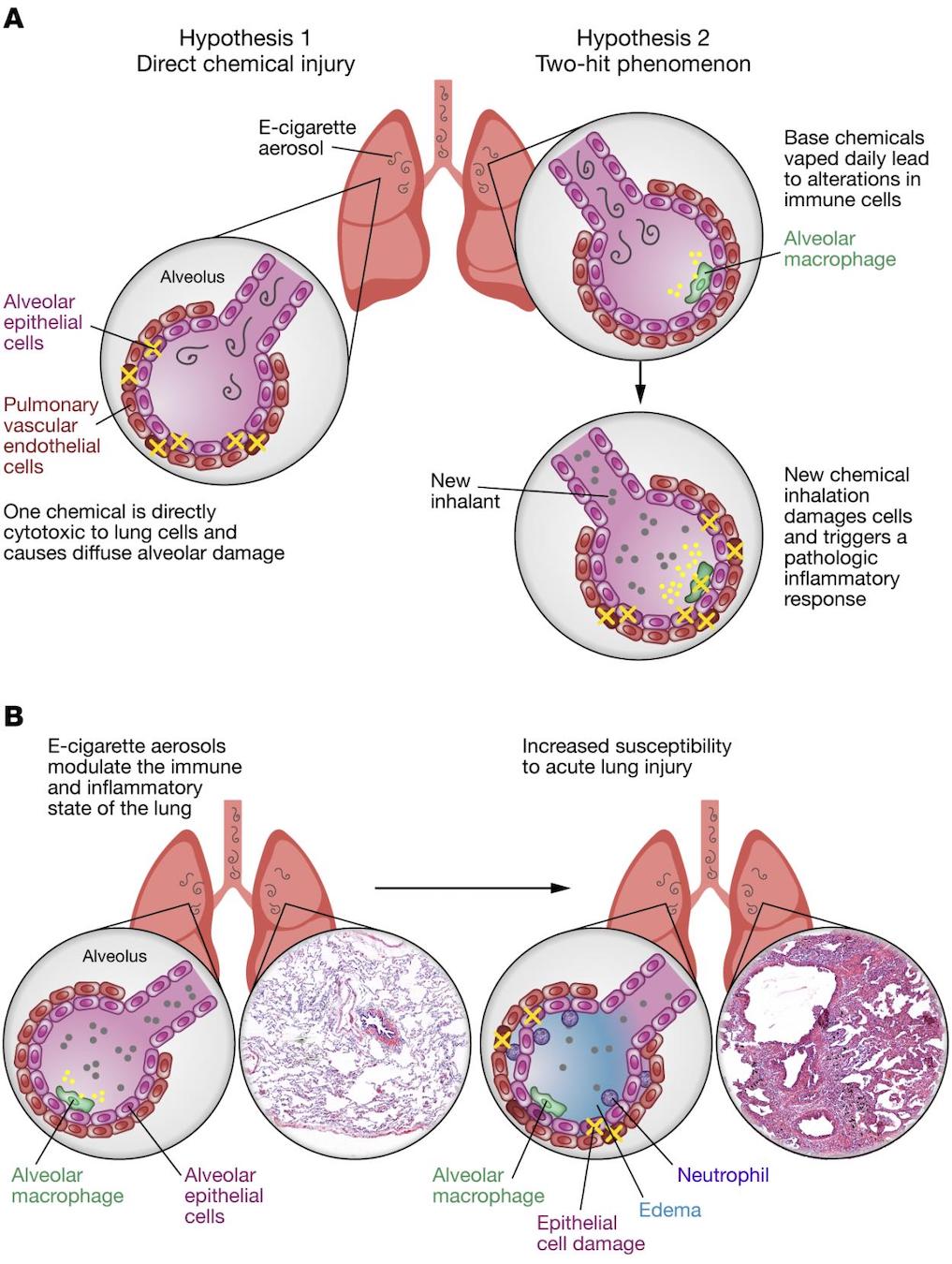 Two main hypothesis for EVALI have been explored, and most fatalities appear to have been more to hypothesis 1 (on the left).
Two main hypothesis for EVALI have been explored, and most fatalities appear to have been more to hypothesis 1 (on the left).
How To Tell If Vitamin E Is In Your Vape
Several studies have shown that the strongest link between all the EVALI cases is the presence of vitamin E acetate in the vapes that patients were consuming, including one which found that 48 of 51 patients sampled had VEA in their lung tissue. Unfortunately, there’s no easy way to tell if you’re vaping products without vitamin E acetate.
The good news is that it appears that most or all of the manufacturers that produce viscosity agents made for cutting vapes no longer use any vitamin E acetate, and fortunately, fatal cases of EVALI have all but disappeared. Still, it’s worth noting that the world of respiratory medicine has been preoccupied since the conclusion of the initial CDC investigation in February 2020, and it’s hard to be certain that ongoing complications aren’t being overlooked.
That being said, even though there’s one or two clues that might indicate VEA isn’t being used in your vape cartridge, there’s too many variables to make that determination without a lot of expertise, and you might want to assume that any vape cartridge with a very thick consistency where the bubbles inside don’t move around COULD be cut with VEA. The problem is that distillate and CO2 oil without VEA can be equally as thick, and by this ‘thickness’ rule you are eliminating a big proportion of all vapes out there.
Because vitamin E acetate doesn’t have any telltale appearance, smell, or taste that you can be sure of, there’s some other steps you can take to avoid vape oil that may contain VEA.
How Do I Find Vaping Products Without Vitamin E Acetate?
If you’re buying from licensed vape producers, it’s reasonable to expect that any vapes manufactured after the EVALI outbreak don’t have any VEA in them. Even homemade or unlicensed producers will have a hard time finding premixed vape additives like Honey Cut that contain VEA. But there’s a few reasons that shouldn’t be too reassuring, especially for vapers in DC.
One of the problems is that efforts to recall products with VEA have been limited and it’s very possible that old stock is still being cleared from inventory, even at licensed retailers. For this reason, it’s a much safer choice to only consume vape cartridges that were manufactured in 2021, ideally within the last 30-60 days (more on that later).
If you’re dealing with an unlicensed vendor, it’s a different story. There’s probably a lower chance of encountering vapes with VEA in 2021, but you should also be aware that it’s not hard to mix your own vape additives and VEA is still a cheap and effective product that is readily available for other purposes.
So while many of the vapes connected to the EVALI outbreak vape epidemic were tested to contain over 30% vitamin E acetate, it’s thought that vapes with 5-10% VEA had already been in use without reported fatalities or serious injuries. It's possible some illicit vendors might continue using small amounts. Even though it’s technically true that lower concentrations of VEA cutting agents are expected to be less deadly, Dr. Strongin of Portland State University advises that a concentration of VEA as low as 12ppm has the potential to cause fatal injuries. That means that a vape pen with only 0.0012% VEA could produce enough ketene gas to kill someone!
Whether or not your particular vendor is worried about that chance is one thing, but if they don’t make the vape oil themselves, there’s a good chance they don’t know for sure what’s in it. Even if they made it themselves, it’s possible that vape additive blends with small amounts of VEA are being sold without disclosing the ingredients to customers.
In other words, the best thing to do is avoid ANY vapes that might be old stock, regardless of where they were bought, and in the case of black or grey market vendors, be very certain that the ingredients they used were sourced from reputable vendors.
No Vitamin E Acetate Vape Oil, No Problem, Right?
We’re definitely glad that investigations into the EVALI vape epidemic that killed dozens of vapers across the US, including one in DC, are finally getting to the bottom of what happened, giving us one less mystery to worry about. But there’s still a lot of reasons to be concerned about using vape cartridges without vitamin E acetate, and that even includes the newest products from licensed medical dispensaries.
When it comes down to it, vape cartridges are a new technology that’s only been available in the U.S. for fifteen years. Long before the EVALI outbreak, and even before use of VEA in vapes, there’s been serious concerns about the health and safety of vape cartridges. There’s basically two major concerns.
The first set of concerns is related to the vape additives themselves and there’s several ways that can become problematic. One of the original theories about the EVALI outbreak is that oil was getting trapped inside people’s lungs and causing them to die of lipoid pneumonia or pneumonitis, which basically means the air sacs in the lungs fill with fluids until a person ‘drowns' from lack of oxygen.
When you vape, the oil inside the cartridge heats up until it turns into a mist that you can inhale, but sometimes, certain parts of the mist cool down inside your lungs and condense back into oil before they can be exhaled. This forms droplets of oil inside your lungs, and most doctors agree that’s still a concern, especially with the use of fillers and thickeners (viscosity agents, if you wanna get fancy).
On its own, that may be enough reason to stop vaping, especially for individuals with chronic respiratory conditions. But the greater concern going forward is that the newer cutting agents like squalene and phytol can also produce toxic byproducts. In fact, researchers have demonstrated that the widely used terpene called squalene is far more unstable than vitamin E acetate and may have a greater potential than VEA to create toxic byproducts. The same goes for phytol, which has also been used extensively to replace VEA. Phytol is actually the chemical precursor used to make vitamin E acetate and phytol has also been shown to produce potentially fatal byproducts when heated.
In order to eliminate the chances of vaping phytol or squalene, your only real option is to choose a vape oil that has ONLY cannabis-derived terpenes. There’s still considerable risks that could occur, especially with hemp-derived terpenes, but the important point is that terms like ‘natural terpenes’, ‘food grade terpenes’, and ‘botanically-derived terpenes’ includes many industrial chemicals that aren’t safe for inhalation. That means you should still be concerned about vapes that say no glycols, MCT, or VEA because not all terpenes are made the same way and many could be harmful.
Finally, it’s important to remember that cannabis vape oil can be contaminated before it’s even cut with an additive, and the presence of pesticides and heavy metals in cannabis extracts has always been a concern. Even in states with pesticide testing, it can be hard to track the fate of products that fail testing and markets like Washington DC make a great place to unload ‘dirty’ products.
Okay, so, if we’re using only cannabis-derived ingredients in cartridges with pesticide-free oil, then we should be okay, right? Well...
Do Vape Cartridges Have Lead In Them?
Besides all the problems with the vape oil, the other ongoing concern with the safety of using vape cartridges comes from the disposable cartridges themselves, and it’s by no means a problem we should overlook. Because vape cartridges have metal components that heat up in close proximity to oils that readily ‘accept’ metals, there’s a high likelihood that many vapers are inhaling small amounts of heavy metals on a regular basis.
There’s been a lot of talk about lead in drinking water, but inhaling heavy metals is far more toxic. The best example is perhaps the infamous ‘mad hatters’ which went insane due to mercury poisoning from chemical fumes. Damage from lead inhalation includes serious consequences including cancer, brain damage, and birth defects.
Lead contamination in vapes isn’t a new concern for licensed cannabis processors, many of which switched to using CCELL brand cartridges with ‘ceramic cell’ heating elements around 2015 after they were shown to leach less metal than other hardware. At the time, CCELL hardware was new and only genuine products were available, but now, many knock-offs are available, including fake CCELL brand cartridge replicas. Almost all vapes these days use ceramic heating elements, but the latest research shows that toxic metals like lead are still getting into cannabis vape oil, even for licensed retailers with lab-tested products.
As it turns out there’s many ways your vape cartridge could be leaking metal into your vape oil, including the ‘pole’ in the middle and the ‘resistance wire’, which both contact the oil directly. Even the outer wall of the vape cartridge and the rings used to prevent it from leaking may also leach plastics and other chemicals into your oil.
So how can you know if you’re using a lead-free vape cartridge?
How Can I Find Metal-Free Vape Carts?
The best way to prevent metals from leaching into your vape oil is to use carts that reduce the contact between the vape oil and unsafe materials. Almost all vape cartridges still contain metal wires that come in direct contact with the vape oil, but some designs are better than others. One reason that CCELLs were originally so popular is that this wire was made of stainless steel, which isn’t perfect, but goes a long way to keep lead out of your vape oil.
To reduce most of these hazards, vendors have the option of using ‘all-ceramic’ cartridges (like these AVD brand or these O2 brand) but they cost between $5-10 each so we don’t expect to see them take over the market anytime soon. We still recommend being diligent about choosing the safer options, but most of the time, you will probably be dealing with CCELLs.
The original CCELLs are still a very popular option, but they are often faked and so it’s important to try verifying you have the real thing. CCELL offers this guide on their website and they are good about responding to questions if you send them pictures and details about what you have.
As mentioned before, AVD is a trusted brand that offers several different options of high quality carts, and cleen tech (formerly Atlas) has made it their company mission to eliminate metal leaching in vape carts.
If you aren’t sure what you’re dealing with, you may want to check out the subreddit r/cleancarts on Reddit and post up some pictures if necessary.
General Tips for Safer Vaping:
- Take care in storing your cartridges. Don’t leave them in hot places like inside a parked car or even in your pocket all day. Store them in a cool place out of sunlight if possible. This will help prevent metal leaching.
- Try to buy the most recently manufactured cartridges available, and don’t use vapes you’ve had sitting around for months. Instead of keeping multiple flavors, keep one or two around and finish them before getting new ones. This also helps prevent metal leaching.
- Use the lowest temperature setting on your vape battery and use the ‘pulse’ technique. Don’t press the button for more than a second and allow the vape to cool between each drag. For example, if you hold the button for one second, wait at least another second before pressing it again. This will prevent the coils from overheating and reduce the chances of producing toxic chemical gasses.
- Don’t ghost your hits. Allowing the vapor time to cool down might allow it to condense and stick to your lungs, making it harder for your body to deal with any contamination that’s present.
Toker Vape Review: Who Has Good Vapes In DC?
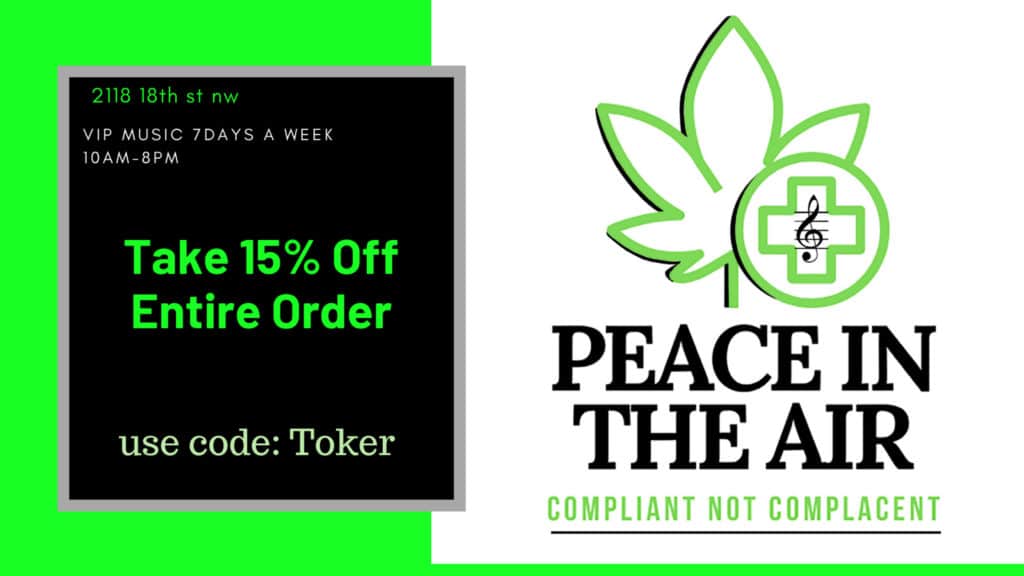 Ok, you want to know who I think has good vapes available in DC, so I’m gonna give you that info in the interest of harm reduction. BUT! I am explicitly not telling you that ANY vape cartridges are safe to use. You should refer to the CDC‘s warning of severe lung damage from vape use when considering risks to your health.
Ok, you want to know who I think has good vapes available in DC, so I’m gonna give you that info in the interest of harm reduction. BUT! I am explicitly not telling you that ANY vape cartridges are safe to use. You should refer to the CDC‘s warning of severe lung damage from vape use when considering risks to your health.
What I can tell you is what DC cartridges use a reputable, local extraction team whose oil, in my opinion, can stand up to any national brand. But hold your horses! The I71 gifting services I recommend may have more than one brand available.
The Gentleman’s quality endorsement begins and ends with these specific items. Full stop. This is not a blanket endorsement of every vape gift they may have now or in the future. I try to keep my information accurate and up-to-date, but please be aware that their available vapes may change without notice.
THC Carts DC Production
Many fake carts are home-brewed. There’s videos on YouTube of how to do it. A vape cartridge is cannabis oil concentrate, typically distillate, in a standard glycol (PG/VG) solution.
I got my packaging in from China!
There was some backlash about the health risks of inhaling glycol a while back, which is what every nicotine-based vape juice uses. Now lots of brands say they don’t use it, that their oil is pure, but you’ll still often have either terpenes or artificial flavoring added. Other plants besides cannabis produce terpenes, too. Say your test results say the vape has a lot of linalool in it. That might be coming from a separate lavender extract added to the oil instead of the cannabis. They also might add an emulsifier if the oil is really thin.
While it’s possible to make your own vape carts, it isn’t economical without the proper equipment and even then, most DC gift weed delivery brands don’t have the time or manpower to fill their own DC cartridges, so they use third party processors. It’s cheaper and faster to buy ready-made packaging that gives your gifts a professional look than to have your own designed from scratch.
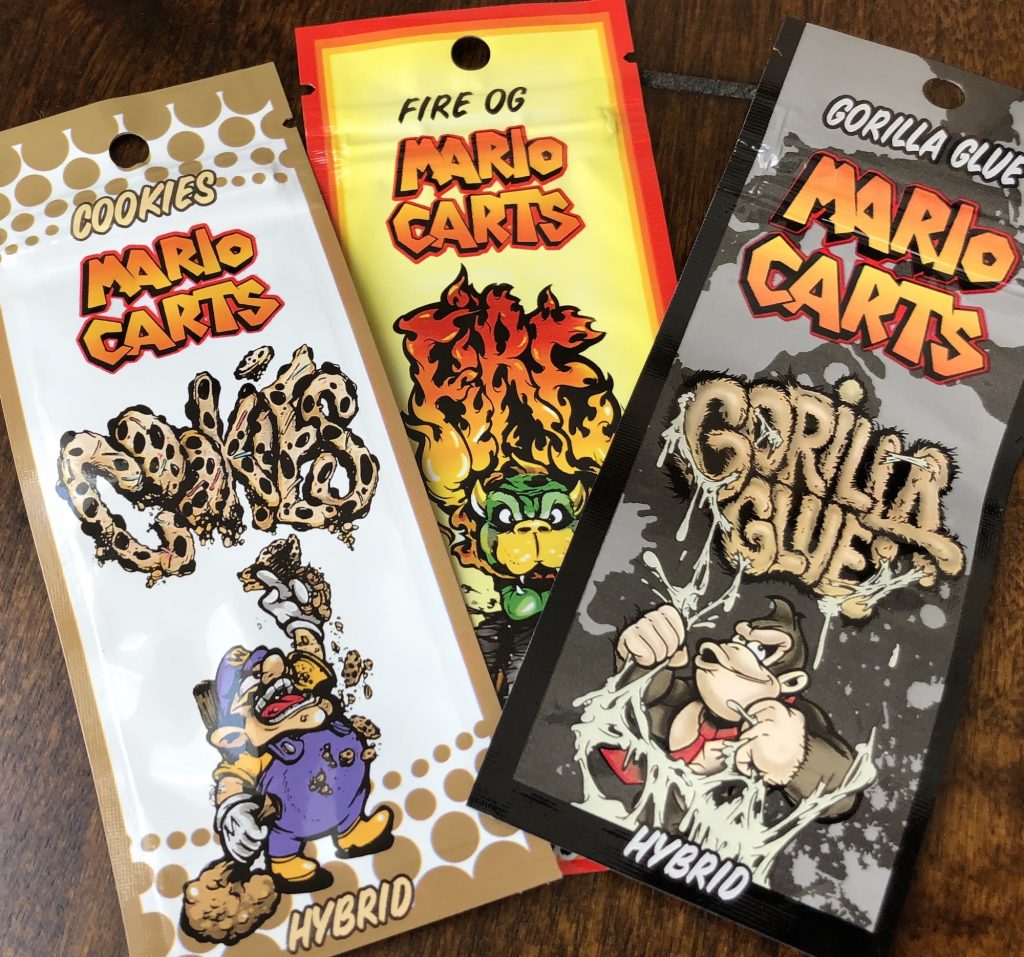
How To Spot A Fake Vape Cart
If it’s a brand name vape cartridge in DC in 2021, it’s almost definitely a fake. The best way to confirm is to get your Google on like I did and see if you can find “vape packaging” plus the brand name. I’ve also included some helpful links I found in my research below. The counterfeiters are keeping pace with the real manufacturers so guides on how to tell are rapidly outdated.
UPDATE! Some legit brands, such as STIIIZY, have implemented a tamper-proof box and serial number or QR code combo where you can verify through their official website that it’s a real product. That seems like a good solution to me, but not necessarily foolproof! It is possible someone might go to the trouble of purchasing tamper-proof tape and mimic the serial code or QR code from a dispensary-bought product.
Another good way to tell is that the THC is printed on the box and not on a separate label applied to the box. A real, state-licensed brand is going to have each batch tested, and you wouldn’t print a single result on an entire run of boxes (typical custom production runs in China start at 10k pieces).
Down The Rabbit Hole of Fake Carts
Since I’ve been on the ground here in DC a while, I know some of the brands that use these processors and fake packages. I wanted to give them their chance to speak about why they use them. I’m not going to call them out individually — it would be unfair to shoulder a few with blame for what is an epidemic in the local cannabis community, especially considering their assistance with this research.
One said they make their own carts with their in-house distillate because they produce a better product than they were able to source.
The other two were both surprised at my suggestion that the brands were fake, claiming they got it straight from the source in Cali and wanted to be sure I said they had the “real” Dank Vapes, Mario Carts, Kingpens, and Brass Knuckles. Except…
Two of those brands suffer from heavy counterfeiting (Kingpen & Brass Knuckles) and the other two don’t exist. They expressed confusion when I told them Dank Vapes and Mario Carts don’t have any presence on Leafly, Weedmaps, Sticky Guide, or any online presence of their own (outside of some sketchy social media accounts).
I was pointed in the direction of the “legit” source the pens came from. They have a website, but it’s kinda barebones. As far as I can tell they’re a pop-up brand from California. I’d rather not pursue it further in print, but suffice to say these didn’t come from a dispensary, despite what it might suggest on the box.
Survey Says!
Consider this. A licensed recreational state brand has a lot to lose if a significant amount of their product gets diverted to gray and black market states.
Since the first days of I71, brave souls with medical cards in other states were smuggling back actual dispensary products in limited quantities, God bless ’em, but not nearly enough to feed this city’s demand.
You should be suspicious of any name brand THC cartridge in DC you’re offered, at least enough to check the internet for fakes.

Fake and counterfeit vape cartridges are likely to contain low quality distillate and/or cut with too much juice (glycol), possibly even contaminated with pesticides.
For perspective, though, many commercial cannabis brands use pesticides allowed by their state statutes. It’s not supposed to end up in the final product, but it absolutely is a thing that happens sometimes. There’s also a measurable amount of acceptable rat poop in your food, in case you’re not up to speed on how capitalism works in the 21st century.
Maryland was unique in that their MMJ program wasn’t going to allow any pesticides at all, but that changed in its first year, underscoring why home-growing laws are important. You don’t have to worry about “economic impracticality” to grow your own medicine.
I’ve had plenty of cartridges from dispensaries locally and across the country that range from middling to awful. Excellent vape carts are uncommon in my experience. Good shops will be able to provide COAs (Certificate of Analysis) upon request, so then you just have to decide whether you can trust the lab that performed the test. Not all labs are created equal, hem hem.
You can’t narrow your expectations by a fake brand as some people make and fill their own cartridges and some people get them from “reputable sources.” So just because I’m looking at a particular Brass Knuckles vape cartridge doesn’t mean every BK cart is cool.
Washington DC Fake Cart List
Here I have put together a list of fake carts. Be sure to double-check packaging, and make sure that none of the vape carts look like they have been tampered with.
Counterfeit! Kingpen Carts Fake
KingPen is a real Cali brand under the LoudPack umbrella currently suffering from rampant counterfeiting. I first reviewed a cart by this name here, but I’m guessing it wasn’t real. This most recent sample from a different source seems awfully similar — too much glycol and harsh distillate. Unsmokeable. It’s super easy to order a full line of Kingpen packaging from China, as you can see below. This means fake Kingpen cartridges are quite easy to make. I have yet to get an actual Kingpen from a dispensary for comparison, but I’m adding it to the To Do list for my next Cali trip. 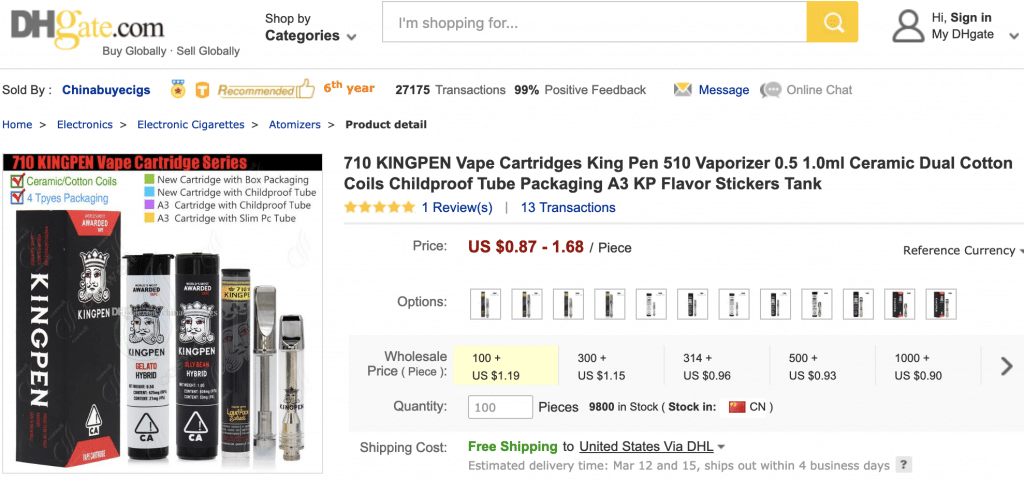
Fake Carts! Mario Carts
This one should be obvious and this is why it made my fake cart list. Every cannabis company that gets licensed in every state has to go through a review process by their state board, and there’s no freakin’ way that ripping off Nintendo games aimed at youngsters is gonna get through. Not. Happening. So when you have a perfect facsimile of Mario or Donkey Kong or any popular cartoon on the package, this is clearly not a legit sold-in-dispensaries brand.
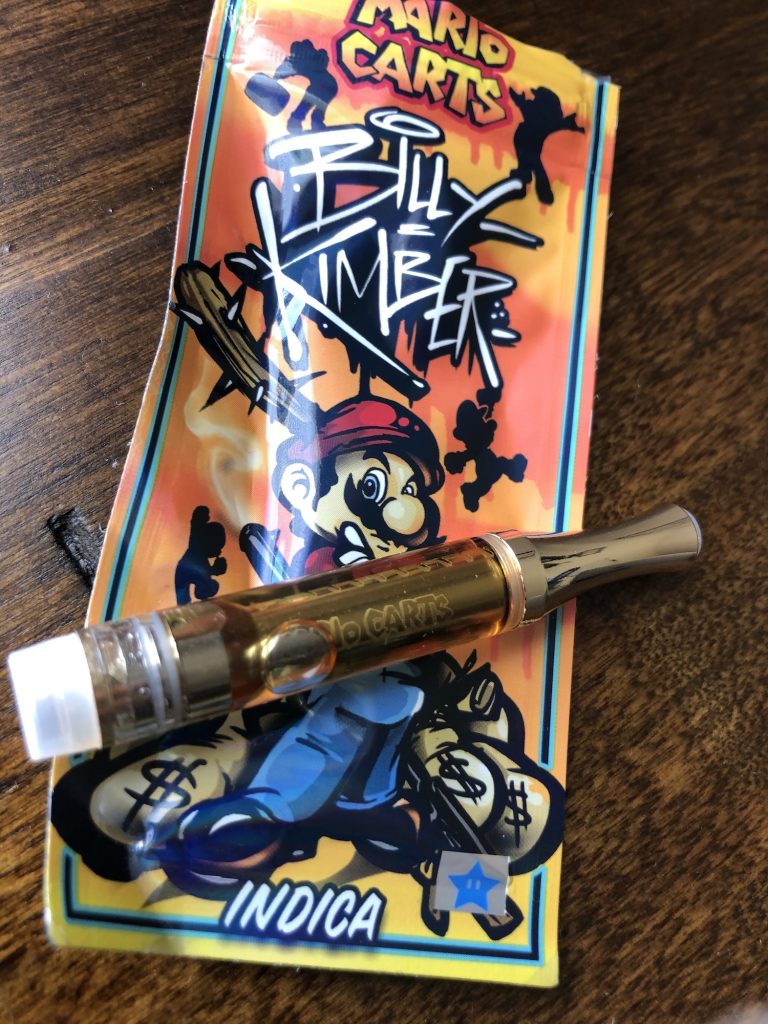
That being said, I got a couple, and here’s what I think: These fake carts are bad. Really bad. I started getting that dirty distillate headache almost immediately after consuming, within a few puffs. Hard no.
Counterfeit! Brass Knuckles THC Cartridge DC
Brass Knuckles was the main subject of this Merry Jane article. China’s counterfeiting these boys so hard it’s like a whole Thomas Crown Affair, you know, where they leave the museum and everyone’s wearing bowler hats to confuse the cops? Anyway, they reported that the Brass Knuckles brand has been Shanghai’d so bad that they’re actually copying the anti-copy holographing that BK implemented to stop the counterfeiting. China has all the same printing presses we have in the US, mijo!

Holographic tape is intact.
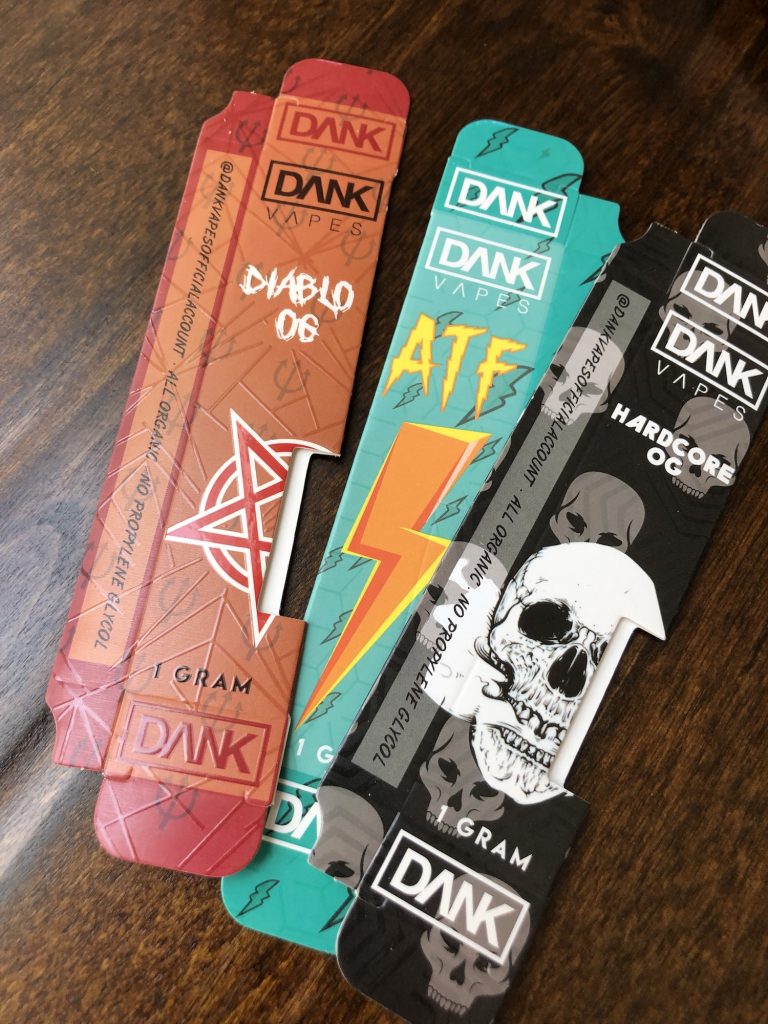
Fake Carts! Dank Vapes
Another fake DC cartridge out there that makes the fake cart list: Dank Vapes. I found this really informative post on counterfeits that suggests Dank Vapes is an offshoot of DankWoods but DankWoods doesn’t mention them on their site, which is pretty sparse. There’s actually a ton of different Dank Vape designs available online, some even sporting holograms. The only claim on this box is the unlikely “All Organic, No Propylene Glycol” and unlikelier 90%+ THC. UPDATE: a reader tip sent me to a California medical collective/delivery service on Weedmaps that sells Dank Vapes. That isn’t as legit as being sold in a recreational Cali dispensary, as Cali’s medical marijuana program has long held a “gray market” notoriety. Coupled with the lack of brand presence (no website, no brand page on any major site like Kingpen or Heavy Hitters) suggests there are many different processors all using the same Dank Vapes branding. Some may have indeed come from Prop 215 Cali brands but there’s nothing stopping anyone from making a batch themselves.
Counterfeit! Heavy Hitters Fake Cartridges
I’d heard of Heavy Hitters through the grapevine and it’s a confirmed real brand, but here’s the super-disappointing screenshot of purchasing the packaging on eBay — complete with holographic counterfeit-thwarting tape. Wamp wamp.
Exotic Carts Fake!
Exotic Carts are also fake. Same as Dank Vapes, there’s a ton of different designs and I actually got them from the exact same online store as the Dank Vapes and in the same package. Oh God, I’m gonna get murdered, aren’t I? Any chance you could hire a supermodel assassin to do it, but, like, seduce me first? I could… I could get down with that.  These say Prop 215 on them, which gives it the impression that it came from a dispensary, but my understanding is that California’s pop-up event brands also claim to operate under Prop 215. Unlike the Mario Carts, the Exotic Cart bags don’t claim to be pesticide-free.
These say Prop 215 on them, which gives it the impression that it came from a dispensary, but my understanding is that California’s pop-up event brands also claim to operate under Prop 215. Unlike the Mario Carts, the Exotic Cart bags don’t claim to be pesticide-free.
Counterfeit! Fake Cartridges Willie's Reserve
Say it ain’t so, Willie! How did you make the list of fake carts!? I didn’t order a batch of Willie Nelson-approved cannabis packaging, but you can see here on Alibaba that they use the exact same photo from the real Willie’s Reserve website. Dammit, Willie, how’d you piss off Beijing? Poker, I bet. Aww, we can’t stay mad at you. 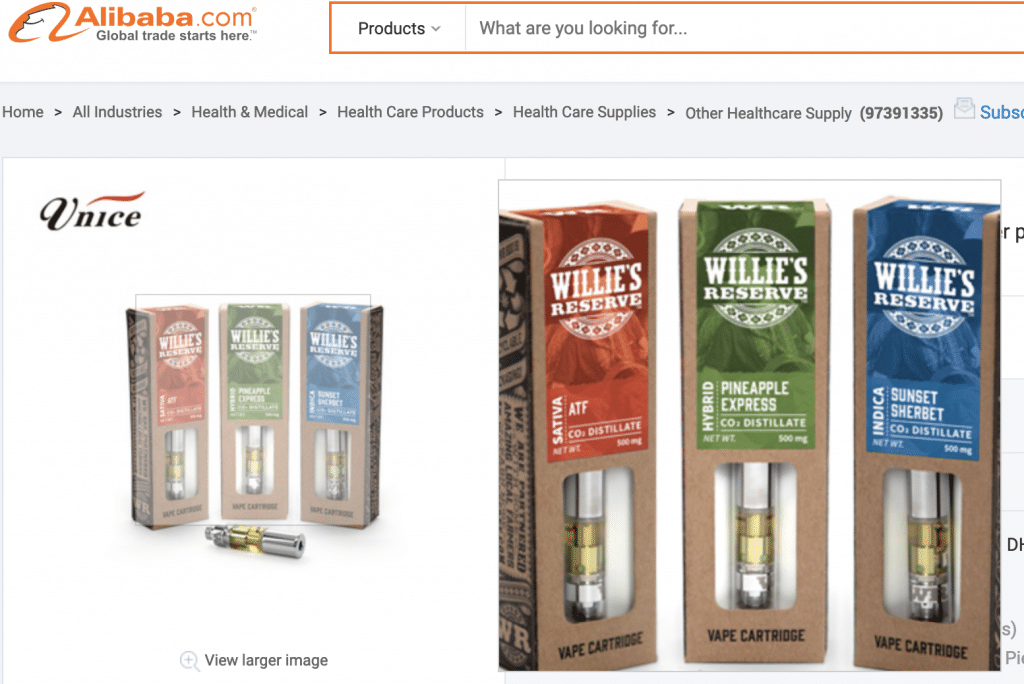
Fake THC CARTS DC! Pure Nectar
Oooh, this looks pretty. It also doesn’t appear on any major weed website or have a website of it’s own. Or a social media page. So… fake. At least there’s no claim on being from Cali included. Here’s my photos of the empty packaging I bought! 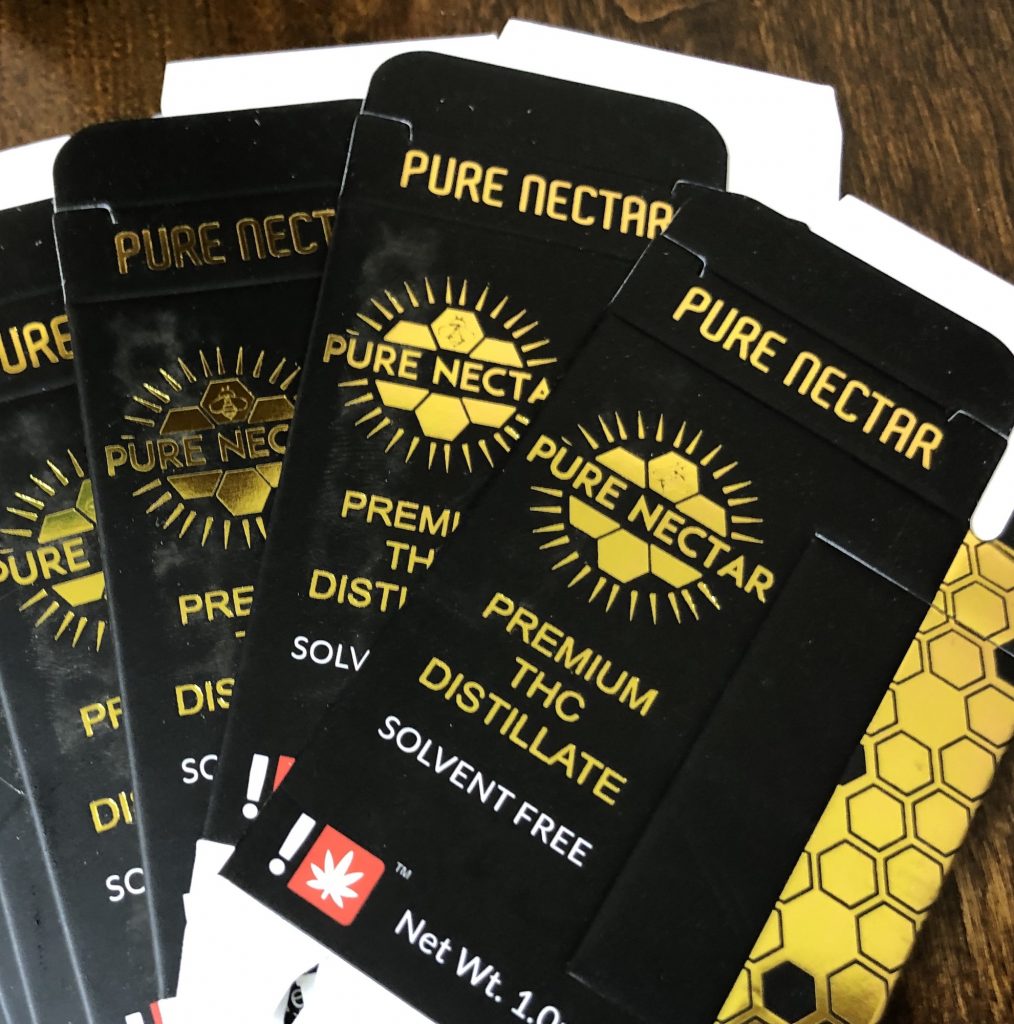 These came from within the US with a nice note about their commitment to customer service and quality. From their ubiquity online, I’m guessing this is an American reselling Chinese packaging and not printing it themselves.
These came from within the US with a nice note about their commitment to customer service and quality. From their ubiquity online, I’m guessing this is an American reselling Chinese packaging and not printing it themselves.
Counterfeit! STIIIZY Fake Carts
Reader tipped me off to another counterfeited California vape pod brand as confirmed in this post on Dab Connection, but their manufacturer links to Shenzhen and searches of Alibaba don’t produce any results for Stiiizy. I found them on DHGate but every listing reads as Out of Stock. However, I just got a junk email from a Chinese manufacturer offering me Stiiizy. So there’s still fakes out there! 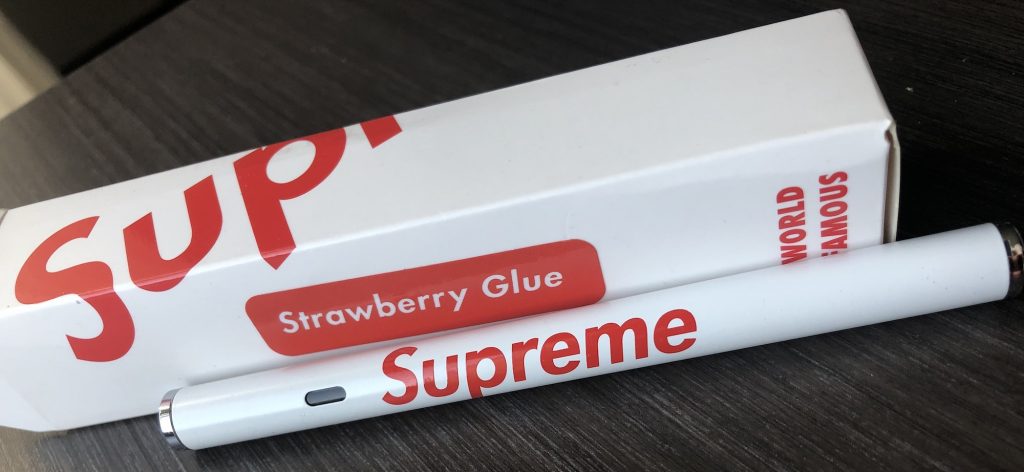
Fake Supreme Cartridges!
Yeah, I was confused the first time I saw Supreme vapes. Isn’t that the same brand flooding Ocean City boardwalk stores with Tupac tee shirts where there’s a SUPREME logo plastered across his eyes? They make vapes now? Evidently not. Here’s one of the websites where you can order their vape packaging yourself. 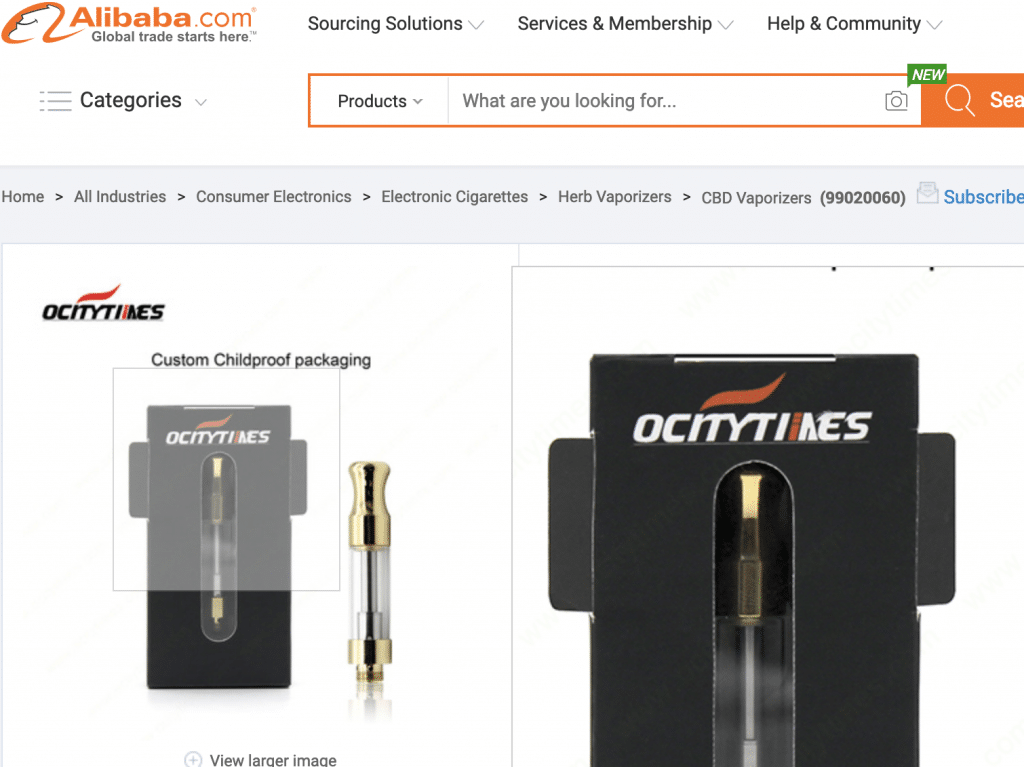
Fake THC Carts! OCityTimes
Notably among the list of Google top-rated suggestions when you type in OCityTimes, “filling machine” comes up. Searching OcityTimes brings us directly to Alibaba and Shenzhen Corp’s own splash page for their OcityTimes complete line of vape hardware and packaging. Not a legit brand in the least. 
Fake! Loud Farmz & Black Market Boyz
I actually found a link to buy “Black Market Boys” and “Loud Farmz” packaging on Leafly from shatterlabelstore.com, which doesn’t work. They do list a phone number (800-585-9509) which has a functioning greeting message. I found Loud Farmz on Alibaba right next to BMB. Both of the packages look kinda basic. Definitely not a legit “sold in dispensaries” brand.
Fake THC Carts! LoudCloud
No online presence on WeedMaps, Leafly, or Sticky Guide. No website of their own (I pull up a vape shop by that name in Mobile, Alabama. I don’t think that’s the same). Not legit! 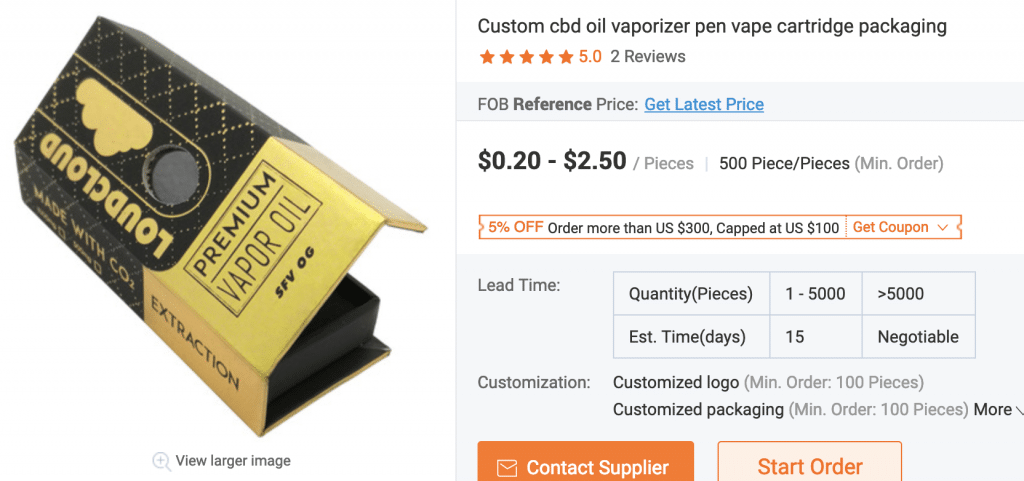
Fake! Blossom Tech
Rounding up our Alibaba search netted Blossom Tech on another Shenzhen splash page. No estas legitimo! 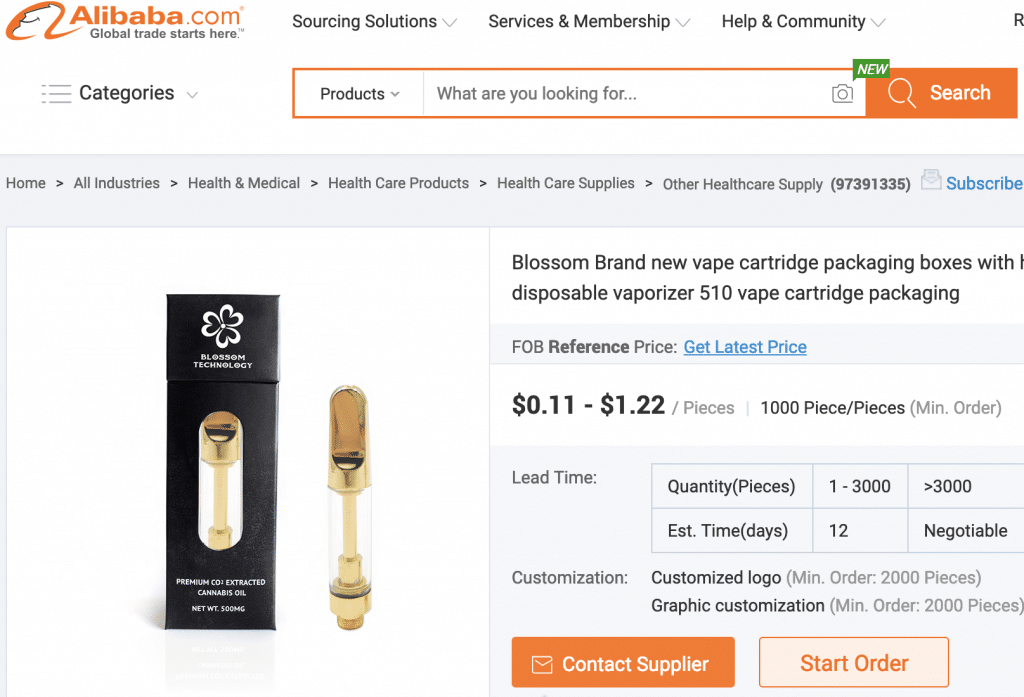
The Fake Carts List Continues
I’ve got junk emails from Chinese manufacturers offering to sell me all of these brands (Updated 7/10/19) with the following note: “Fast delivery with competitive price, usual leakage rate around 3% frankly.” LOL.
I’m also sad to say I have to add Friendly Farms to the list of fake carts — I’ve found some really excellent vapes by that name, but the packaging is indeed fake. I’ve found the popular Cookies brand vape packaging available along with Dabwoods and Alpine Glass on DHGate. I’ve also found Los Angeles Kush Farms on Amazon. Someone asked me about Ice Cream Vapes recently which I couldn’t find online but doesn’t sound at all legit. You’d never get that branding approved by any state’s program.
Final Thoughts On DC Fake Carts List
It is a sad day when you are looking for a good DC cartridge but have to wonder if you are smoking fake carts or not. Hopefully my list of fake carts has brought awareness to the seriousness of this epidemic. While not all brands are selling fake cartridges, you still have to be careful and pay close attention to what you are purchasing and consuming. From fake supreme cartridges, to fake kingpen cartridges, no brand is safe. As long as the Gentleman is here you can be sure that I will always be the first to point out when I have come across fake cartridges.
Research:
Websites
- https://en.wikipedia.org/wiki/2019–2020_vaping_lung_illness_outbreak
- https://www.chemistryworld.com/news/e-liquids-linked-to-us-deaths-form-deadly-compound-when-vaped/4011000.article
- https://mjbizdaily.com/oregon-cannabis-regulators-ban-additives-first-seen-in-vaping-crisis/
- https://www.ccell.com/discover/how-to-check-if-ccell-cartridge-are-authentic
- https://youtu.be/BWm-POlGCs0
- https://www.health.harvard.edu/blog/evali-new-information-on-vaping-induced-lung-injury-2020040319359
- https://www.yalemedicine.org/conditions/evali
- https://emergency.cdc.gov/agent/phosgene/basics/facts.asp
Scientific Journals
- Alexander, Laura E., et al. “What Are the Mechanisms Underlying Vaping-Induced Lung Injury?” Journal of Clinical Investigation, vol. 130, no. 6, 2020, pp. 2754–2756., https://doi.org/10.1172/jci138644.
Early research makes the case for two different hypothesis on cause of death- one related to pneumonia/pneumonitis from oil droplets and the other to an unknown constituent causing chemical burns. - Guo, Weihong, et al. “Major Constituents of Cannabis Vape Oil Liquid, Vapor and Aerosol in California Vape Oil Cartridge Samples.” Frontiers in Chemistry, vol. 9, 2021, https://doi.org/10.3389/fchem.2021.694905.
Lab analysis of vape cartridge oils; some that were directly used by EVALI patients, some that were not. Shows samples containing greater than 30 percent vitamin E acetate. - Ciolino, Laura A., et al. “Evali Vaping Liquids Part 2: Mass Spectrometric Identification of Diluents and Additives.” Frontiers in Chemistry, vol. 9, 2021, https://doi.org/10.3389/fchem.2021.746480.
Over 300 vape additives products are analyzed for their components. - Holt, Alaina K., et al. “A Retrospective Analysis of Chemical Constituents in Regulated and Unregulated e-Cigarette Liquids.” Frontiers in Chemistry, vol. 9, 2021, https://doi.org/10.3389/fchem.2021.752342.
Another study that analyzes the components in different 'e-liquids'. This one has a great introduction that briefly covers the history of vapes and the EVALI outbreak. - Blount, Benjamin C., et al. “Vitamin E Acetate in Bronchoalveolar-Lavage Fluid Associated with Evali.” New England Journal of Medicine, vol. 382, no. 8, 2020, pp. 697–705., https://doi.org/10.1056/nejmoa1916433.
Examination shows 94% of EVALI patients had vitamin E acetate residue in their lung tissue. - Smith, Maxwell L., et al. “Vaping-Related Lung Injury.” Virchows Archiv, vol. 478, no. 1, 2020, pp. 81–88., https://doi.org/10.1007/s00428-020-02943-0.
Overview of EVALI pathology which shows that, "no well-characterized radiologic and pathologic cases" for lipoid pnuemonia as a cause of death. - Wu, Dan, and Donal F. O’Shea. “Potential for Release of Pulmonary Toxic Ketene from Vaping Pyrolysis of Vitamin E Acetate.” Proceedings of the National Academy of Sciences, vol. 117, no. 12, 2020, pp. 6349–6355., https://doi.org/10.1073/pnas.1920925117.
One of the earlier studies looking at the possibility of ketene gas being produced by vitamin E acetate. - Duffy, Bryan, et al. “Analysis of Cannabinoid-Containing Fluids in Illicit Vaping Cartridges Recovered from Pulmonary Injury Patients: Identification of Vitamin E Acetate as a Major Diluent.” Toxics, vol. 8, no. 1, 2020, p. 8., https://doi.org/10.3390/toxics8010008.
Identifies constituents of EVALI-linked vapes to contain pesticides and their diluents to include vitamin E acetate, the terpene a-bisabolol, and squalene. - Strongin, Robert M. “Toxic Ketene Gas Forms on Vaping Vitamin E Acetate Prompting Interest in Its Possible Role in the EVALI Outbreak.” Proceedings of the National Academy of Sciences, vol. 117, no. 14, 2020, pp. 7553–7554., https://doi.org/10.1073/pnas.2003384117.
Demonstrates the mechanism for production of ketene from vitamin E acetate. - Vas, Gyorgy. “Evaluation of Vitamin E Acetate Volatile Degradation Products; a Possible Connection to the EVALI Epidemic.” Reviews in Separation Sciences, vol. 3, no. 1, 2021, https://doi.org/10.17145/rss.21.004.
Shows that potential for the production of toxic chemicals from vitamin E acetate is low at the temperatures vape manufactures claim are created in their devices. - Wagner, Jeff, et al. “Vaping Cartridge Heating Element Compositions and Evidence of High Temperatures.” PLOS ONE, vol. 15, no. 10, 2020, https://doi.org/10.1371/journal.pone.0240613.
Examination of various vaping hardware with pictures that detail internal components. Also measures the internal temperatures and demonstrates that vape cartridges can easily reach unsafe temperatures. - McDaniel, Charles, et al. “Metals in Cannabis Vaporizer Aerosols: Sources, Possible Mechanisms, and Exposure Profiles.” Chemical Research in Toxicology, vol. 34, no. 11, 2021, pp. 2331–2342., https://doi.org/10.1021/acs.chemrestox.1c00230.
This paper quantifies the presence of heavy metals in the actual vapor that is produced from cartridges purchased at licensed retailers in Washington State and demonstrates that the cartridge hardware itself was the source of contamination. - Schwotzer, Daniela, et al. “Phytol, Not Propylene Glycol, Causes Severe Pulmonary Injury after Inhalation Dosing in Sprague-Dawley Rats.” Inhalation Toxicology, vol. 33, no. 1, 2021, pp. 33–40., https://doi.org/10.1080/08958378.2020.1867260.
Canadian study funded by Canopy Growth that shows adverse effects of phytol.



